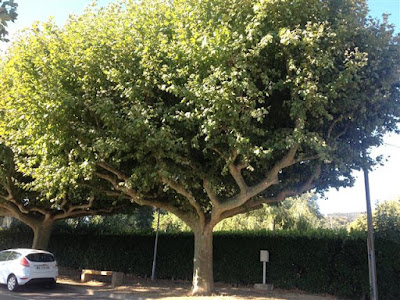While in Tournon we saw a statue of Marc Seguin, a famous
18th century French Engineer.
After visiting the world’s first steam locomotive to carry
passengers designed in 1825 by the British brothers George and Robert
Stephenson, Seguin managed to acquire, and then sneak, two of Stephenson's steam
engines back France for closer inspection.
After dismantling one of them and examining their design—a form of industrial
espionage—Seguin had an idea of how to significantly enhance the efficiency of Stephenson's
design. This idea was the multi-tube
boiler: which involved replacing Stephenson’s large water tube within the fire
box through which water passed to be heated into steam with a large number of much
smaller-diameter tubes. By passing water
through these small tubes, Seguin was able to increase the area being heated, significantly increasing the engines ability to produce steam.
He designed two steam locomotives using his multi-tube
boiler and also included, amongst other innovations, mechanically driven fans
to increase the draught and hence heat of the fire. Using his design, Seguin's was able to increase
the speed of the train from 5km/hr to 40 km/hr.
A picture of a replica of Seguin's steam engine can be viewed on Wikipedia.
Seguin went onto construct several railways including the Vivarais
railway line. A steam train—called the Ardèche
Train—now operates on his line today.
The steam engine (sadly, not of Seguin’s design) operates for tourists. We took this train journey.
Seguin was also famous for designing suspension bridges in France. By the end
of his life he had built and had administered 186 toll-bridges. Seguin wrote a number of books on bridges and
locomotives engines. His name is inscribed on the Eiffel Tower: just one of only
72 names.
 |
| View from the River Rhone. |
 |
| View of the Rhone. |
 |
| View on the Rhone. |
 |
| View of Rhone from Tournon. |
 |
| View of Bridge over Rhone at Tournon. |
 |
| The Village of Tournon. |
 |
| Andance |
 |
| Wayne & Julie in Tournon |
 |
| Wayne in Tournon |
 |
| Marc Seguin in Tournon. |
 |
| The Ardèche Train. |
 |
| Inside the Ardèche Train. |
 |
| View of road bridge from the Vivarais railway. |
 |
le temple d'auguste et de livie vienne.
A temple dedicated to the cult of Rome and Augustus built around 20BC, |

























































